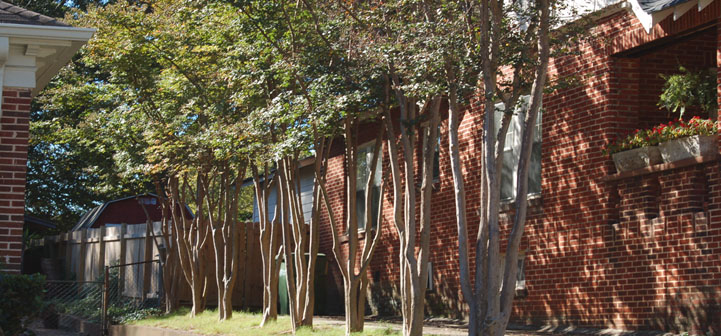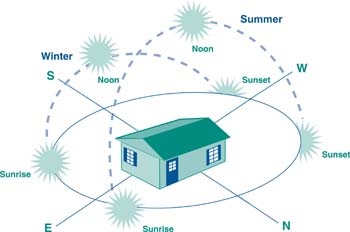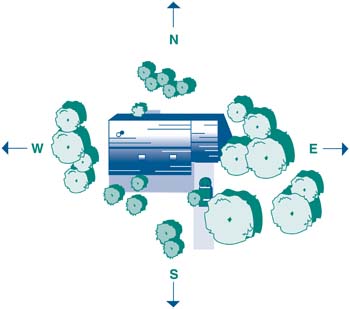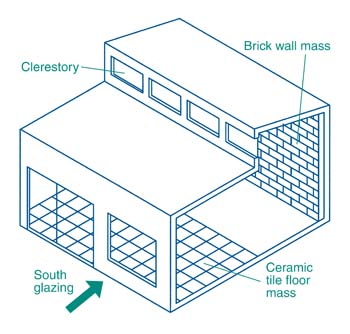Reviewed and Revised on 10/25/2013
Designing for the Climate
In warm climate regions such as the Gulf where temperatures are high year round, designing for the climate means designing to reduce heat gain is the first priority. Orientation (direction a home faces) and careful planning of available home space are “free” ways available at the designing stage of new homes which can help to cut energy costs upfront and make a home comfortable and highly functional.
Landscaping for energy savings: Even with roof overhangs, a great deal of solar heat gain on the west, east, southwest, and southeast sides of a house can occur from the rising and setting sun. Cooling demand can be greatly reduced by providing shade structures, trees, and shrubs on these sides of a house. Deciduous trees (trees that loose leaves in winter) are preferred to provide shade in the summer and let in the winter sunlight.
Pavement reflects and radiates heat that it absorbs from the sun. Avoid unshaded pavement near the house. Small shrubs, ground cover, and non-reflective mulches keep the area around the house cooler and reduce reflected heat.
In winter it can be helpful to deflect cold north winds over or around the house with an evergreen barrier.
Overall house design: The more surface area the building envelope has the more is the heat gain and loss. As compact the plan is to a square (or circle), the less exposed surface area there is for the same living area. Space-efficient design with open planning can help save energy by reducing the overall size of a house. Open planning saves on room clearance and pathways while making areas appear and feel larger.
Kitchens and laundry rooms typically have house heat-producing appliances, so don’t place them on the west side to avoid compounding the afternoon heat buildup. Locating kitchens and living areas for northern or southern exposures can provide a lot of natural daylight without a lot of heat gain. Placing the washer, dryer, and freezer outside of conditioned space can reduce cooling loads even further.
Supplement a compact house design with porches, patios, or other planned outdoor areas to extend the living space outside the conditioned space. The ideal is to include a shaded area on the north side for summer use and an area on the south side for winter use.
Additional informational about exterior architectural design impacting energy efficiency is available here.
Design to minimize solar heat gain: West- and east-facing glass can have nearly five times the solar heat gain of north-facing glass, and more than triple that of south-facing glass. Although the amount of radiant heat at west and east exposures is the same, west is most important to protect, because it occurs during the hottest time of the day. Design to minimize west and east glass and wall surface, and shade it. Try to place most of the home’s glass area within 20 degrees of due south or north.
Skylights are not generally recommended, because they receive too much sun and are difficult to shade. Light tubes (domed glass roof fixtures coupled with an insulated reflective tube) are an exception. They can provide a lot of diffuse, reflected light without the heat gain, but must be correctly installed to prevent leaks and should be storm resistant.
Choosing roofing and siding colors with good solar reflectance (25% or more) can result in tangible cooling energy savings. This is particularly true for roofing materials such as light-colored tile and metal, now available with solar reflectances up to 75%. Dark colors generally absorb heat from sunlight, whereas light surfaces reflect heat and reduce cooling costs. A new option is a “cool color” metal roof coating, or shingle granule technology, that gives darker colors the heat reflectance of light colors.
ENERGY STAR labeled roofings have a solar reflectance of at least 25% (for steep sloped roofs). For optimal performance in a hot climate, choose a roofing with a high solar reflectance (> 50%) and a high emissivity (> 80%). Materials, such as painted metal, with high emissivity release heat more rapidly to the atmosphere (cool off at night) than low emissivity materials (e.g. unpainted metal).
Design for passive solar winter benefits: A passive solar home is designed to admit and store energy from the sun in winter for solar heating. To even out temperature swings, south-facing glass (with overhangs sized to admit winter sun) on the main living space should be coupled with thermal mass, such as tile or brick on a slab floor or a masonry partition wall. The best performing thermal mass is relatively thin and spread out, covering an area in the room about six times the south-facing glass area. The thermal mass must receive direct sunlight, but it is not necessary for sunshine to reach all of it.
Design for mild seasons: When the outside humidity is not high in spring and fall, a home designed with good cross ventilation can be comfortable without air conditioning. Wing walls can be designed to capture breezes from the east/southeast and deflect them into south windows. Room arrangements should allow flow through ventilation. A screened porch should be open on three sides for ventilation or in a breezeway for maximum comfort and use.
A free online tool BEopt (Building Energy Optimization) developed by NREL (National Renewable Energy Laboratory) is available for anyone to use, to analyze new home design for energy optimization, based on characteristics such as size, location, occupancy etc.








